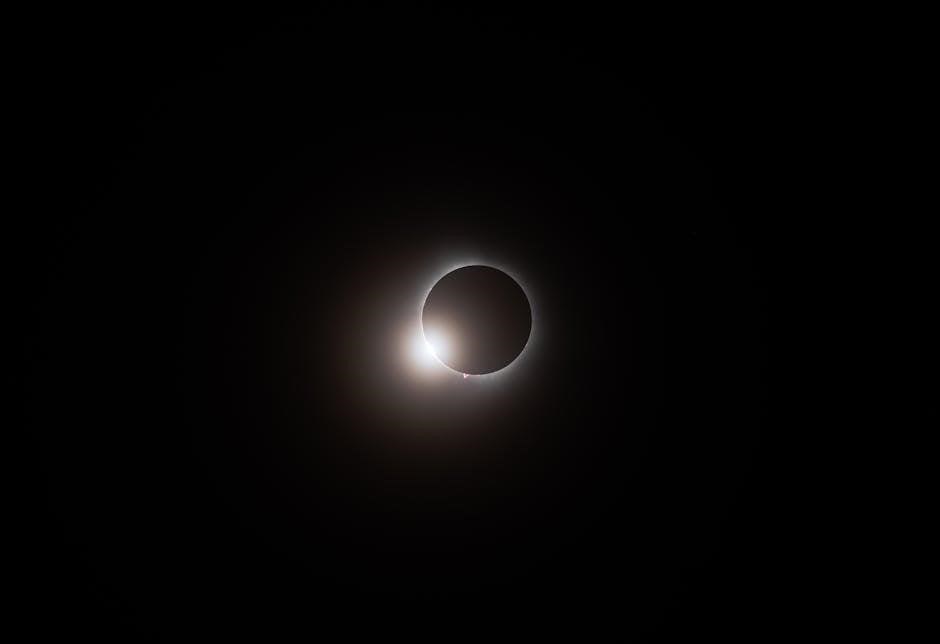Solar Eclipse 2024 Lesson Plans: A Comprehensive Guide
Prepare for the spectacular 2024 solar eclipse with our comprehensive guide! This resource compiles lesson plans, activities, and partner resources, ensuring educators have access to free downloadable PDFs. Elevate learning with NASA resources, simulation tools, and safety guidelines, making the eclipse an unforgettable educational experience.
The April 8th, 2024, total solar eclipse offers a unique educational opportunity, captivating students across the United States. A solar eclipse occurs when the Moon passes between the Sun and Earth, casting a shadow and, in the path of totality, completely blocking the Sun’s light. This event provides a hands-on way to teach astronomy, physics, and earth science.
In 2017, a partial solar eclipse was visible across the contiguous U.S., and 2024 brings another incredible opportunity. Depending on your location, you might witness a total solar eclipse, a rare and awe-inspiring phenomenon. This guide provides lesson plans and resources tailored for different grade levels, ensuring teachers can effectively integrate this event into their curriculum.
Explore NASA’s resources, including maps and visualizations, to understand the eclipse’s path. Discover citizen science projects where students can contribute to real research during the eclipse. Prioritize safety with guidelines for viewing the eclipse properly. By blending science, technology, and cultural perspectives, make the 2024 solar eclipse a memorable learning experience.
Understanding Solar Eclipses: The Science Behind the Phenomenon
Solar eclipses are celestial events rooted in precise astronomical mechanics. They occur when the Moon aligns directly between the Sun and Earth, casting a shadow on our planet. The type of eclipse observed depends on location within this shadow. A total solar eclipse happens when the Moon completely obscures the Sun, revealing the Sun’s corona, a breathtaking sight.
Partial solar eclipses occur when the Moon only partially covers the Sun. Understanding the geometry of the Sun, Moon, and Earth is crucial. Lesson plans should explain the orbital paths and the concept of umbra and penumbra – the darkest and lighter parts of the shadow, respectively. Students can model these positions to grasp why eclipses don’t happen every month.
Explore the science behind the corona, the Sun’s outer atmosphere, visible only during totality. Discuss why we don’t usually see it and what it reveals about the Sun’s activity. Integrate data visualization to show the eclipse’s path across the Earth, helping students understand their location’s experience. This scientific understanding enriches the eclipse viewing experience.
NASA Resources for Eclipse Education

NASA offers a wealth of resources for educators seeking to enhance their eclipse lessons. Their website provides comprehensive guides explaining solar eclipses, including interactive simulations and visualizations. These tools allow students to explore the eclipse path and understand the alignment of the Sun, Moon, and Earth.
Explore NASA’s 2023 and 2024 Solar Eclipse Map to visualize the paths of both the annular and total eclipses. Use the “My NASA Data” lesson plan for grades 3-5 to model solar eclipse geometry. This hands-on activity helps students understand the positions of the Sun and Moon during an eclipse. Provide the Total Solar Eclipse Viewing Path worksheet, allowing students to plot the eclipse’s path on April 8, 2024.
NASA also offers videos explaining the science behind eclipses, safety guidelines for viewing, and citizen science opportunities. Access these resources to integrate technology into your lessons and encourage student participation in data collection. Leverage NASA’s expertise to provide accurate and engaging content, ensuring students grasp the scientific principles governing this celestial event.
Free Downloadable Lesson Plans and Activities
Enhance your solar eclipse curriculum with our selection of free downloadable lesson plans and activities! These resources are designed to engage students of all ages, offering a blend of science, astronomy, and technology. Download lesson plans from TRAILS for illuminating classroom activities on eclipses, ensuring an interactive learning experience.
Explore resources like the “Solar Eclipse Activity Lesson Plan” from the Exploratorium, blending science and technology into classroom activities. The National Science Teaching Association provides eclipse guides, resources, and webinars. The “Solar Eclipse Double-Header (PDF)” offers additional educational materials, and Science Buddies presents ten astronomy lesson plan options.
These readily available resources provide educators with diverse tools to explain the science behind solar eclipses. Incorporate hands-on activities, simulations, and data analysis to deepen student understanding. The lesson plans cover various aspects of eclipses, from understanding their formation to exploring their cultural significance. Download these free resources and inspire your students with the wonders of the 2024 solar eclipse!
Eclipse Simulation Tools and Data Visualization
Immerse your students in the science of solar eclipses using advanced simulation tools and data visualization techniques. Eclipse simulators, such as those provided by Eclipse2024.org and NASA, allow students to explore the eclipse from any location. Speed up or slow down time to observe the Moon’s movement in front of the Sun, visualizing the ethereal glow of the Sun’s corona during totality.
With the Solar Eclipse 2024 Data Story, students can see what the eclipse will look like from various locations. These tools help explain why we don’t usually see the corona, enhancing understanding of the eclipse’s unique features. NASA’s 2023 and 2024 Solar Eclipse Map shows the paths of both eclipses, providing a visual context for learning.
Utilize My NASA Data Lesson Plan, “Modeling Solar Eclipse Geometry,” to engage grades 3-5. Students can plot the viewing path on a worksheet, fostering hands-on learning. These simulations and visualizations not only enhance comprehension but also make the eclipse a captivating and interactive educational experience.
Safety Guidelines for Viewing the Solar Eclipse
Prioritize safety when observing the 2024 solar eclipse. Emphasize the importance of using proper eye protection to prevent severe eye damage. Regular sunglasses are insufficient; instead, use certified solar viewing glasses or handheld solar viewers that meet the ISO 12312-2 international safety standard. Inspect these glasses for damage before use and discard if compromised.

Directly viewing the sun without proper protection, even during a partial eclipse, can cause permanent retinal damage. Supervise children closely to ensure they adhere to safety guidelines. An alternative safe viewing method is using a pinhole projector to indirectly observe the eclipse. Create a simple pinhole projector with cardboard and paper to project an image of the sun onto a surface.
Never look at the sun through a camera lens, telescope, or binoculars without a certified solar filter, as these can concentrate the sun’s rays and cause immediate, serious eye injury. Educate students and the community about these safety measures to ensure a safe and enjoyable eclipse viewing experience.
Integrating Technology into Eclipse Lessons
Enhance eclipse lessons by integrating technology to create engaging and interactive learning experiences. Utilize eclipse simulation tools and data visualization software to illustrate the eclipse’s path, stages, and scientific principles. These tools allow students to explore the phenomenon from different locations and perspectives, fostering a deeper understanding.

Incorporate online resources like NASA’s eclipse website, which provides real-time data, images, and educational materials. Use virtual reality (VR) and augmented reality (AR) applications to create immersive simulations of the eclipse, allowing students to experience totality without directly viewing the sun. Encourage students to use smartphone apps that track the eclipse’s progress and provide safety information.
Employ data analysis tools to examine eclipse-related data, such as temperature changes and atmospheric conditions. Facilitate collaborative projects using online platforms, where students can share observations, analyze data, and create multimedia presentations. By integrating technology, educators can transform eclipse lessons into dynamic, inquiry-based learning opportunities that inspire scientific curiosity and critical thinking.
Citizen Science Opportunities During the Eclipse

The 2024 solar eclipse presents a unique opportunity for students to participate in citizen science projects, contributing valuable data to scientific research. Encourage students to join initiatives like NASA’s citizen science programs, which involve collecting data on temperature changes, cloud cover, and animal behavior during the eclipse. These projects provide hands-on experience in scientific data collection and analysis.
Students can use smartphones and other devices to record observations and submit data through dedicated apps and online platforms. By participating in these projects, students learn about the scientific method, data analysis, and the importance of collaboration in scientific research. They also gain a sense of ownership and contribution to the scientific community.
Moreover, citizen science projects foster a deeper understanding of the eclipse and its effects on the environment. They encourage students to become active participants in scientific discovery, promoting scientific literacy and a lifelong interest in STEM fields. The data collected by citizen scientists can help researchers better understand the effects of solar eclipses and improve future predictions.
Addressing Eclipse Myths and Cultural Perspectives
Explore the rich tapestry of cultural beliefs and myths surrounding solar eclipses from around the world. Incorporate discussions on how different cultures have historically interpreted eclipses, from omens of disaster to symbols of renewal. Examine myths from various indigenous communities and compare them to scientific explanations.
Encourage students to research and present on eclipse myths from different regions, fostering cross-cultural understanding and respect. Discuss the historical context of these myths and how they reflect the values and beliefs of the societies that created them. Contrast these traditional interpretations with the scientific understanding of eclipses, emphasizing the importance of evidence-based reasoning.
Additionally, address any misconceptions or fears that students may have about eclipses, providing accurate scientific information to dispel myths. By exploring both the cultural and scientific aspects of eclipses, students can develop a more nuanced understanding of this awe-inspiring phenomenon. This approach promotes critical thinking and challenges students to consider multiple perspectives.
Resources for Different Grade Levels
We offer tailored resources to accommodate various grade levels, ensuring age-appropriate engagement with the 2024 solar eclipse. For elementary students, focus on basic concepts like the Sun, Moon, and Earth’s alignment using interactive models and visual aids. Activities include creating diagrams and storytelling about eclipse myths.
Middle school resources delve into the science behind eclipses, exploring concepts like umbra, penumbra, and the geometry of celestial bodies. Students can participate in hands-on experiments, such as modeling eclipse geometry and analyzing data from previous eclipses. High school materials tackle advanced topics like the physics of light and the corona, using simulations and data visualization tools.
Each grade level includes adaptable lesson plans, printable worksheets, and assessment tools to support teachers in delivering effective eclipse education. We provide differentiated activities to cater to diverse learning styles and abilities, ensuring all students can participate and understand the phenomenon. These resources foster scientific literacy and critical thinking skills.
Partner Resources and Educational Overviews
Enhance your solar eclipse lesson plans with resources from our esteemed partners! The Indiana Department of Homeland Security provides a comprehensive 2024 Total Solar Eclipse Educational Overview. The National Science Teaching Association offers eclipse guides, resources, and webinars, plus a valuable “Solar Eclipse Double-Header” PDF.
The Exploratorium features a hands-on Solar Eclipse Activity Lesson Plan, while Science Buddies offers ten distinct astronomy lesson plan options. These partner resources are designed to complement your existing curriculum and provide diverse perspectives on solar eclipses.
Educational overviews cover the science behind eclipses, safety guidelines for viewing, and cultural significance. They also often include background information on previous eclipses, like the 2017 event, and comparisons to the upcoming 2024 eclipse. Leverage these collaborations to create a rich, multifaceted learning experience. These resources provide a wider range of options and will enrich your lesson plan.
